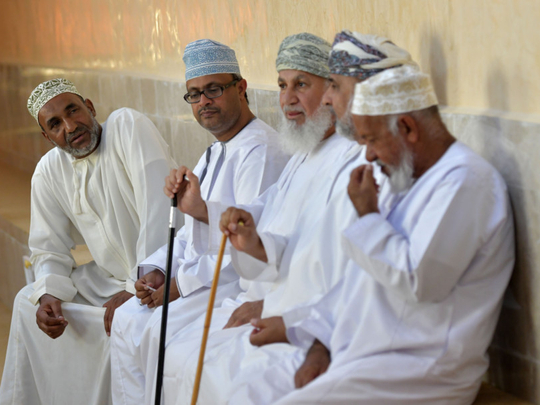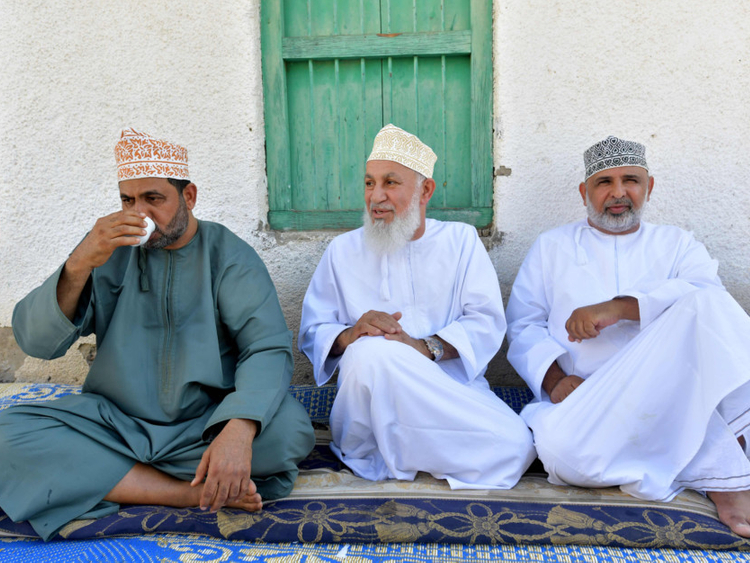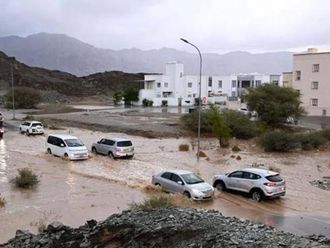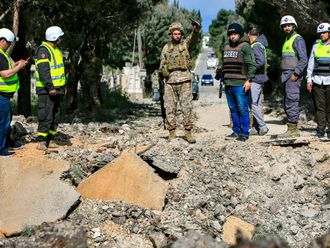
Ghala: Omani Mahmoud bin Yousef Temtemi found himself in a pastoral predicament this autumn - his neighbour’s flock of sheep had overrun his farm and gobbled up his crops, threatening his income.
Rather than make a scene or turn to the police, Temtemi chose to raise his complaint in Omani tradition: through the local “sabla”, or council.
Dressed in a robe and embroidered cap, Temtemi took his place on a sunny Friday morning at his neighbourhood sabla in the village of Ghala - held outdoors on a patch of sidewalk.
“The farm is our livelihood,” Temtemi told an AFP correspondent attending the meeting.
“I told myself I would lodge a complaint at the sabla, where the owner of the sheep would be present.”
In Ghala, just outside the capital Muscat, the sheikh humbly brings breakfast for meetings of the council. The youngest serves coffee.
The fellowship broke the ice for the mediation Temtemi sought. Acknowledging a problem needed to be solved, the men filed over to the meeting hall - a sparse room with little more than benches built into the walls.
The elders listened to the farmer’s story, discussed, then decided on compensation from the sheep owner.
“He will pay 150 riyals ($390) and keep an eye on his sheep,” said a satisfied Temtemi.
Oman’s sabla is a unique form of consensus building that many see as central to the Gulf nation’s traditions, and which some want to see adapted to the age of the smartphone.
“This council is where the old and young come to learn. The youth learn manners from their elders,” grey-bearded Sayeed bin Khalfan Nabhani said in Ghala.
Nabhani said the history of the sabla goes back “ages”, but some 40 years ago - after Sultan Qaboos ascended the throne Oman - it was granted a degree of government recognition.
“From the early 1970s, you had the governor and judge sitting at the council, along with witnesses and people of the villages - plus the person with the problem,” said Nabhani.
A solution is often found before the judge is called to get involved, he said.
In far-flung areas, the sabla remains central to life, but even there it is changing, with women for example reserving the hall for their own meetings.
Hilal al-Siyabi, an Omani community activist, believes the sabla can - and should - keep up with the times.
In the lush Muscat suburb of Saael, a new kind of sabla is under construction.
A shell of a building stood off the main road, a mountain range in the background.
Siyabi’s voice echoed as he pointed to where LCD screens would be installed and computers set up for a future internet cafe.
“We are leveraging on the concept of sabla to do something much better - something which is beneficial to today’s community,” he said.
This centre would embrace the whole family, he explained, with a special emphasis on the young.
Siyabi said an exploratory meeting three years earlier was packed with curious residents - notably women.
“Young women,” he said. “They were excited to have such a centre. They said, ‘We are not working but we are going to sell our precious gold to contribute to something like this.’”
Siyabi said the government has fully supported the initiative, which seeks to build on tradition in a changing world and keep conflict resolution local.
He sees the sabla evolving from its role as a mediation authority to a town hall-style forum and community centre.
For Muscat-based public policy analyst Ahmed al-Mukhaini, the sabla is a “microcosm” of the Omani state: discreet and tribal.
“You don’t hang out your dirty linen,” Mukhaini said, adding it was no surprise the government supports the continuation of the sabla.
Under Sultan Qaboos, Oman has not replaced the sabla - now a “benign form of assembly”, the analyst said, but institutionalised it, with modern forms of government continuing to function in the same patriarchical and hierarchical way.
“In Oman they spend a lot of time on consensus building, versus majority-based decisions,” Mukhaini said.
Authorities in Muscat continue to recognise tribal chiefs as official representatives, registered with the interior ministry.
Each tribe’s “rasheed”, or interlocutor, functions as a conduit to the government, often feeling out sentiment on domestic policy changes, such as recent healthcare privatisation proposals.
“I’m not aware of any other country where tribal leaders are on a payroll or where the system of sheikhdom is controlled by the government,” Mukhaini said.
Even the modern Shura council, Oman’s only elected body, is dominated by tribal heavyweights - not the technocrats and intellectuals found in the council of state appointed by the sultan.
“The system that remains until now keeps tabs on public opinion or resentment,” said the analyst.
When Qaboos overthrew his father in a bloodless coup in 1970, the British-educated ruler reached out to the tribes in an early radio address, reassuring tribal leaders and promising to institutionalise their role.
The sabla is so important to Omani culture that it will even decide who will succeed the 77-year-old sultan when he dies.
“Basic law gives the appointment of the next sultan to the royal family sabla,” Mukhaini said.
If the cousins of Qaboos - he has no brothers or heir apparent - fail to choose a successor within a matter of days, Mukhaini said it will fall to the defence council, chief justice and Shura council to reach a consensus, this time on behalf of the nation.













